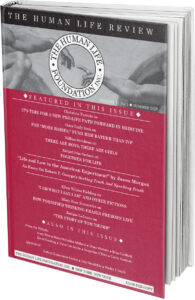The Surprisingly Controversial IVF Alternative Dividing Washington
The following was first published on Oct. 16, 2025, by the Washington Examiner. Read the original here.
__________________________________________________________________________________
It may seem like pronatalism is the province of the Right, but when it comes to technological intervention, everyone wants to be the champion of babymaking. In the 2024 presidential election, both parties rushed to lay claim to in vitro fertilization, the procedure responsible for nearly 100,000 births each year. As a vice presidential nominee, Tim Walz claimed to have used IVF to grow his family, despite using intrauterine insemination, an entirely different procedure. On the campaign trail, President Donald Trump boasted that he was “the father of IVF.”
As with many medical interventions associated with desperate would-be parents, there is money to be made with IVF. It is a $25 billion global industry, yet its success rate means it’s no panacea for struggling couples.
“Overall, first-time IVF success rates often fall between 25-30% for most intended parents,” Elite IVF reports. Many hopeful parents have to undergo three or more rounds of treatment and shell out tens of thousands of dollars to get their happy ending.
Access to IVF is now often framed as a human right. A 2024 editorial from the Lancet cautioned that “a profit-driven fertility industry cannot continue to prey on the vulnerabilities of people who desperately hope to have children,” arguing that significant problems associated with IVF include “stigma” and unequal access.
Even as support for IVF has grown in the GOP, there are still concerns, particularly among pro-lifers, about its cavalier treatment of human embryos, up to a million of which are on ice at this very moment. Infertility affects more than 1 in 10 couples who want to conceive. There must be another approach, one without IVF’s baggage. So what is it? And is anybody talking about it?
An alternative to IVF
I was just 28 years old when I first had a physician recommend IVF to me. It was early during my fifth pregnancy, which ended with the birth of my second, healthy baby boy. I was thus spared from having to consider the nuclear option — though as a pro-lifer, if I did pursue IVF, I would not want to create more embryos than I could ultimately attempt to carry. Despite various tests, the source of my miscarriages never became clear. But I was troubled that my OBGYN’s default was to recommend that I shell out tens of thousands of dollars for an intervention I may never need.
It wasn’t until recently that I first heard of restorative reproductive medicine, an approach popular in religious circles but frowned upon by the medical establishment. The American Society for Reproductive Medicine refers to RRM as “misleading terminology.”
“What distinguishes RRM is not medical practice but ideology,” the organization argues. “It typically excludes IVF and related treatments on moral or religious grounds, not clinical evidence. Its proponents create a false narrative that standard fertility care skips proper diagnosis or healing, when in fact, it is based on precisely those principles.”
RRM advocates say otherwise.
“Restorative reproductive medicine (RRM) is a specialized field of medicine that focuses on identifying the underlying health conditions that contribute to reproductive dysfunction and suboptimal reproductive health, treating them to restore the natural functions of the reproductive system,” according to the International Institute for Restorative Reproductive Medicine. “Unlike conventional approaches that use treatments that suppress normal physiology to deal with dysfunction, RRM seeks to work with the body, treating reproductive abnormalities, not by bypassing the body’s processes but by diagnosing, understanding, and addressing underlying health concerns.”
What does that look like in practice? Tracking various aspects of a woman’s menstrual cycle to look for abnormalities; screening for underlying conditions such as polycystic ovarian syndrome or endometriosis; analyzing the male partner’s reproductive health — at least one-third of infertility cases come from the man — and creating a “multidisciplinary” treatment plan, which “may include personalized hormone therapies, ovulation induction, luteal phase normalization, other medications, supplements, surgery, and lifestyle adjustments.”
This method purports to treat infertility, recurrent miscarriages, and other gynecological conditions. It sounds innocent enough. So why does the American College of Obstetricians and Gynecologists call it a “nonmedical approach,” issuing the dire warning that it “can expose patients to needless, painful surgical interventions; limit their access to the full range of evidence-based fertility care interventions; and delay time to pregnancy, while potentially increasing overall costs”? Isn’t IVF potentially a painful and expensive intervention itself?
Who’s afraid of RRM?
On Capitol Hill last month, dueling briefings laid bare the arguments on two heated sides of the fertility question. The American Society for Reproductive Medicine, whose affiliate group accredits IVF clinics, “expressed concern that framing restorative reproductive medicine as an IVF alternative could steer resources away from IVF providers or give insurers an excuse to exclude coverage for IVF in the future,” according to an NBC report.
Katelyn Walls Shelton, a visiting fellow at the Ethics and Public Policy Center’s Bioethics, Technology and Human Flourishing Program and a Washington Examiner contributor, attended the briefing and was struck by the American Society for Reproductive Medicine’s apparently mercenary motives. “The main takeaway” of its briefing, she wrote on X, was that the organization was “worried funding for RRM will take away funding for IVF.”
Rep. Debbie Wasserman Schultz (D-FL) seized the moment to take a shot at IVF’s self-proclaimed father: “The administration is putzing around with this RRM option now and the president is stepping back from his commitments,” she said.
Much of the distaste for RRM among the medical establishment seems to come from the fact that the approach has become associated with pro-lifers and the “Make America Healthy Again” movement. Of course, people who oppose IVF for religious or other reasons deserve a fertility treatment that’s suitable for them, regardless of whether the medical establishment finds their morals to be quaint and bothersome. But strip away the politics, and RRM may offer more than meets the eye.
The other briefing was hosted by the International Institute for Restorative Reproductive Medicine, which marshaled women to tell their stories.
“Like so many women, I was swept into the IVF establishment because I had no symptoms,” said Marie Guccione, a mother who spoke at the briefing and credits RRM with the birth of her two daughters. “If IVF is seen as the best option, it very quickly becomes the only option. But women deserve better.”
Apples to oranges
It’s true that IVF vs. RRM is not an apples-to-apples comparison because one involves creating embryos outside of the womb and reinserting them with the hopes of beginning a healthy pregnancy. The other involves many different types of interventions, but not that one. It’s therefore hard to compare the cost or effectiveness of the two approaches, though even surgery is likely to be cheaper than a round or two of IVF. One 2021 study of 370 couples pursuing RRM found that after two years, 29% had successfully given birth, a potentially higher rate than that for a first round of IVF.
The wholesale rejection of RRM by the mainstream medical establishment is representative of how incurious it can be, which is, in fact, one of RRM’s criticisms. This discussion also illuminates how little concern the average medical practice has for those with conscience concerns regarding technological reproductive interventions. Four out of every 10 people identify as anti-abortion, and many of us believe that even a human embryo outside the womb deserves personhood protection, including the Alabama Supreme Court.
When it comes to treating infertility, would-be parents deserve a choice that not only takes a holistic approach to health but also aligns with their values. Even as both political parties try to outdo each other in support for IVF, struggling couples deserve alternatives. That alone should make RRM worth our attention.










I’ve always been against I.V.F..Some doctors call this procedure “micro-abortions”.More than one human embryo is inserted into the womb,hoping that one will nidate.Those that don’t nidate are “sloughed-off” perish, die.
One really valuable approach would be for women to marry and try because earlier in life. Delayed motherhood can impair fertility.